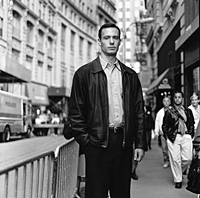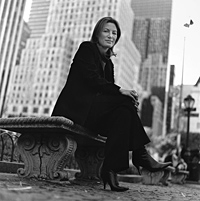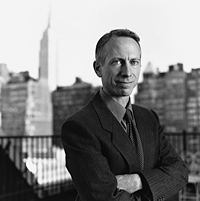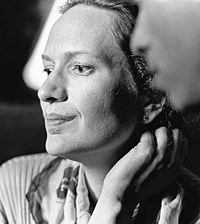|
In
the shadow of the towers
Kellogg
School alums near the WTC when the planes hit share what they
saw, and how their lives changed in the aftermath of Sept.
11
By
Matt Golosinski
| |
 |
| |
© Nathan Mandell
|
| |
Brian
Lessig '99 fled a 20-story-tall cloud of debris. |
| |
|
It was not
an ordinary dust cloud that chased Brian Lessig ’99 up
West Broadway the morning of Sept. 11, filling him with the
certainty that he was about to die. What pursued the young investment
banker and thousands of others who ran screaming from the epicenter
of the terrorist attacks on the World Trade Center was a roiling,
angry avalanche of ash, steel, office furniture and human carnage.
And glass.
Lots of it.
As the
south tower fell, Lessig remembers standing in the street,
mesmerized by the enormity of the spectacle. He watched the
first dozen floors implode one after another and then, only
when it appeared that the blazing skyscraper was toppling
directly onto him, did he run.
“I
had dress shoes on and I ran faster than I’d ever run
in my life,” said Lessig, an associate with Merrill Lynch,
who was late for work that day and so had not entered the
corporate offices located in 4 World Financial Center, about
400 feet from the WTC complex, when the first plane hit the
north tower. He ran for what seemed like blocks, but the nightmare
clung to his heels. “When I looked back, there was a
20-story mushrooming explosion coming toward me. I said ‘I’m
dead. I am going to die.’”
He could
have died earlier that morning. If he hadn’t been exhausted
after a weekend at a Kellogg wedding in Wisconsin, he would
have never hit the snooze button on his alarm. If his buddy
hadn’t bought Lessig a ticket to the Green Bay Packers
game a day earlier, the Kellogg alum wouldn’t have had
to stop, remembering his obligation just as he was leaving
his apartment, and return to his desk inside where he wrote
his friend a check and thank-you note. The effort took only
a few minutes, but minutes wasted that morning may have saved
Lessig’s life.
Other
Kellogg alums found themselves even closer to the disaster
as it unfolded.
 |
|
|
© Nathan Mandell
|
|
"Everything
looked like a target," said
Liz Kaiser '00. |
|
| |
|
Nowhere
to run
“I was
in a meeting when I heard a big ‘boom.’ I thought
somebody dropped a copier machine in the building,” remembers
Liz Kaiser ’00, an associate at Merrill Lynch. Just three
weeks earlier, Kaiser had transferred from Merrill’s Chicago
offices to Manhattan. She hadn’t even had time to learn
where the stairs were in her new building at 2 World Financial
Center.
Kaiser
and some colleagues gathered along the row of windows in their
40th-floor suite that overlooked the World Trade Center. What
Kaiser saw didn’t make sense: an icon building on fire
and “miniature chairs” tumbling out of it to the
ground 400 feet below. Just as she thought that some “stupid
Cessna pilot” must have accidentally crashed into the
tower, a gigantic fireball erupted from WTC One, rushing across
West Street at Kaiser, threatening to slam into her own office.
“Our
windows shook and we stood there with our eyes wide open,”
says Kaiser. “Then all hell broke loose. Everyone was
screaming. I pulled one of my co-workers off the phone and
said ‘We’re going!’ I didn’t get my purse.”
Kaiser
and her “escape buddy” became part of the herd of
people fleeing the building, filling the hot stairwell and
trying to make their way outside. The crowd remained orderly,
she recalls, although everyone feared it was taking too long
to exit the office. At any moment, they thought, the floors
above them might also come crashing down. With people fainting
and coughing around her, “it took everything to stay
calm,” says Kaiser.
When she
reached the street, Kaiser emerged into chaos. Flames and
noxious smoke engulfed the WTC complex. Sirens screamed. Debris
lay everywhere. Papers fluttered down from the sky. Kaiser
remembers seeing org charts, memos, PowerPoint presentations
-- things that had meant so much minutes earlier, turned into
litter.
“You
could make out the company names on the paper,” she says.
“That’s one of the things that made it so human.”
Kaiser
walked for three hours in high-heeled shoes, joining a parade
of refugees dressed in ash-smeared business suits. The crowd
marched out of Manhattan in near total silence.
As she
fled, Kaiser looked around at a landscape transformed into
something terribly alien. “Suddenly, everything looked
like a target,” she says. “You look at the Statue
of Liberty, and it’s a target. You look at the Stock
Exchange, and it’s a target.”
In fact,
Lessig, who found himself alongside New York mayor Rudolph
Giuliani as the Financial District was evacuated, says that
people didn’t want to walk within 20 blocks of the Empire
State Building. After the second plane hit, New Yorkers thought
the entire city was under attack.
“People
just wanted to get away. They dove into the river and tried
swimming across to New Jersey,” Lessig reports. “They
didn’t even want to be on the ferries.”
Even a
few miles uptown, panic gripped people evacuating their offices
as a precaution. Carol Spomer ’78 was among those worried.
The director of financial services for Entrust, an Internet
security firm, was feeling anything but secure as she filed
out onto Madison Avenue with her colleagues.
“Someone
reported smelling gas,” says Spomer, whose office lies
between Grand Central Station and Times Square. “I had
already seen the two towers go down and now I’m thinking
this gas leak is part of the next terrorist attack.”
She waited
for the subway below her feet to explode. “We felt really
vulnerable,” Spomer says. “I couldn’t sleep
that week. I just kept watching CNN, trying to understand
the reality of this.”
Kaiser,
a native New Yorker, also found herself searching to comprehend
the devastation.
“As
I walked home that day, all I kept thinking about was moving
to Iowa and opening a little one-story shop,” she says.
Pulling
out white-hot steel
Two
months later smoke continues to rise from the volcano of WTC
wreckage that covers more than six acres and whose foundations
reach 70 feet into the earth.
The sickly
sweet odor -- a gruesome reek feeding on plastic, diesel and
a thousand other materials -- has hovered over Manhattan since
Sept. 11 and still remains. It is through the ash and smell
that the tragedy quite literally becomes part of anyone visiting
the scene.
“We’re
still pulling white-hot steel out of the debris, and we’re
going to be doing that for months,” says Lee Benish ’82,
vice president of strategic relationship management for AMEC,
a preeminent international high-rise construction management
company. AMEC was among the handful of companies called upon
by the state and city of New York after the attacks for their
construction expertise.
“The
core temperature of the rubble is still 1,700 degrees,”
adds Benish, an EMP-7 graduate, during an interview in October.
He was at the site hours after the attacks, assisting his
company’s operations. “To see this mass of destruction,
even now, is a humbling, overwhelming experience. Three blocks
away windows are broken. You go to an adjacent building and
there’s a steel beam penetrating the façade.”
Benish,
whose company also is assisting with recovery efforts at the
Pentagon, is surprised the WTC disaster didn’t claim
more lives.
“I’m
amazed we didn’t lose 50,000 people,” he says. “The
tragedy of the numbers killed is horrific, but when you realize
that these 110-story buildings collapsed into 80 feet -- that’s
all the file cabinets, the ceiling tiles, the concrete, the
mechanical systems, rebar floors, 22,000 windows -- you can
imagine how the losses might have spiraled higher.”
The reason
the death toll didn’t rise higher than it did, says Benish,
is that the towers collapsed as they were designed to do:
more or less straight down, preventing excessive lateral damage.
The
aftermath
Many
Americans fear that the events of Sept. 11 may prove less
rare than one would imagine. New Yorkers are universally known
for their toughness, but some, including Rick Linde, Kellogg’s
class representative for 1982, don’t hide their concern.
“Yes,
I’m afraid of living in New York now, but I’ve lived
here with my family for 20 years and to leave would be a cowardly
abdication,” says the executive recruiter for Battalia
Winston, whose offices are located about three miles from
where the WTC stood.
“I
refuse to let these terrorists disrupt my life any more than
they already have,” he adds. Linde believes the best
thing people can do now is follow the advice of Mayor Giuliani,
whose motto has been “Get back to business.” Go
to a show, says Linde, or enjoy dinner out on the town. Spending
money in New York, he suggests, is one way people can help
the city recover.
Such action
may seem difficult, even futile, in the face of an enormous
tragedy, and Linde himself didn’t begin to appreciate
the advice until weeks after the attacks. In fact, he nearly
declined to submit his class news for Kellogg World. But then
he realized that doing his part to maintain the Kellogg network
represented an important contribution to his own recovery,
and the recovery of others.
“Here
I had all these chipper notes from classmates talking about
the new boat they bought,” says Linde, who received the
updates before Sept. 11. “I felt that submitting this
material was totally irrelevant. Then I started thinking about
how things that really help people forge and rebuild human
relationships, like Kellogg World, are even more important
to us now.”
Kaiser
agrees. She says that part of what sustained her through the
attacks was the Kellogg network, especially the hundreds of
alums who flooded the school’s Web site and an associated
site called finebrand.com, either providing information about
a Kellogg
peer, or inquiring about the status of a classmate.
“Knowing
that you have these people looking out for you is just amazing,”
says Kaiser.
| |
 |
| |
© Nathan Mandell
|
| |
Doug
Bell '89 volunteered in the rescue efforts by driving
a Red Cross shuttle. |
| |
|
The generosity
of people around the world has also touched Doug Bell ’89,
president of the NYC-based advertising firm that bears his
name.
This benevolence
serves as the counterpoint to the horror surrounding the attacks,
and in some ways, it’s made it more difficult to sort
out his feelings. “There are all these emotional angles
coming at you,” says Bell. “In The New York Times
we’ve read all these stories, thousands of them, about
the victims. At the same time, people are again learning how
to appreciate a nice day and enjoy their friends. It’s
confusing. We don’t yet have a place to put this.”
The “deep,
deep sorrow” created by the attacks has profoundly affected
Bell. “It keeps coming back,” he says. “You
see something on the television or hear a story about someone,
and there’s nothing to say, nothing to do. It’s
really bad.”
But Bell,
like others who volunteered their services after the attacks,
did find a way to help, though he points out that volunteers
with specialized emergency training were the ones in high
demand.
“You
totally feel helpless,” admits Bell, who was “lucky
enough” to help staff a Red Cross center and then work
as a shuttle driver and dispatcher for the agency.
 |
|
|
© Nathan Mandell
|
|
| In
the attack's aftermath, Beth Adler '86 says New Yorkers
have become more considerate. |
|
| |
|
For Beth
Adler ’86, until recently a senior vice president at
Sony Classical, the Sept. 11 aftermath has rekindled in her
an appreciation for simple social graces. “People are
starting to be more humane to one another,” she says.
“People in my apartment building are reaching out more
to neighbors, not just coming home with the take-out dinner
and the video.”
Lessig
agrees. “People have really mellowed out since this happened,”
he says.
These
welcome changes come, of course, at a great cost. For Adler,
flying back into New York will never be the same. “Suddenly
your landmarks are gone,” she says. “It’s like
a piece of your heart is cut out.”
When Bell
contemplates the site’s wreckage, he finds himself struck
by the terror and power he sees in the twisted girders.
“Here’s
all this potential energy that was up 110 floors above the
earth,” says Bell. “All the amazing energy and capability
that went into that building came down at one time.”
The tragedy
of Sept. 11 cannot be undone, Bell knows, but part of him
believes that “we still have all that power, that energy,
and the capability to build it all again.”
Ed.
note: In the aftermath of the Sept. 11 attacks, Kellogg World
solicited reactions from alumni who live and work in New York.
We invited those who could attend an October fundraiser in
Manhattan to share their stories with us there for this feature.
We are grateful for their contributions, and for the efforts
of Kellogg’s NYC alumni club which organized the event.
The money raised has been donated to funds established in
the names of the Kellogg alumni who died in the attacks.
"In
Memoriam" for those alumni lost in the attacks of Sept.
11
|



